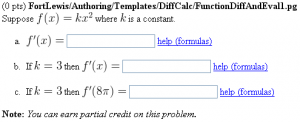DifferentiateFunction1
This problem has been replaced with a newer version of this problem
Differentiating and Evaluating a Function
This PG code shows how to create a function using MathObjects, differentiate it, and evaluate it.
- PGML location in OPL: FortLewis/Authoring/Templates/DiffCalc/DifferentiateFunction1_PGML.pg
| PG problem file | Explanation |
|---|---|
|
Problem tagging: |
|
DOCUMENT(); loadMacros( 'PGstandard.pl', 'MathObjects.pl', 'PGML.pl', 'PGcourse.pl' ); TEXT(beginproblem()); |
|
Context('Numeric')->variables->add(k=>'Real');
Context()->flags->set(
reduceConstants=>0, # no decimals
reduceConstantFunctions=>1, # combine 4+5*2?
formatStudentAnswer=>'parsed', # no decimals
);
$a = random(6,9,1);
$k = random(3,5,1);
$f = Formula('k x^2');
$fx = $f->D('x');
$ans1 = $fx;
$ans2 = $fx->substitute(k=>$k);
$ans3 = $fx->substitute(x=>$a*pi,k=>$k);
|
Setup:
The partial differentiation operator is
The main difference between
$k into the Formula $f returns a Formula $k x, if we had used the eval method $ans2 = $fx->eval(k=>$k); instead of the substitute method, we would get errors because $k x is a Formula, not a Real. Note: You cannot use eval or substitute to perform function composition, i.e., you can only plug in numbers, not formulas.
When the answer is a constant, we can use either the eval method, in which case the answer would be a Real, or the substitute method, in which case the answer would be a constant Formula. If you use the eval method, For more details, see eval versus substitute, formatting correct answers, and constants in problems. |
BEGIN_PGML
Suppose [` f(x) = [$f] `] where [` k `] is a constant.
a. [` f ' (x) = `] [_______________]{$ans1}
b. If [` k = [$k] `] then [` f ' (x) = `] [_______________]{$ans2}
c. If [` k = [$k] `] then [` f ' ([$a]\pi) = `] [_______________]{$ans3}
[@ helpLink('formulas') @]*
END_PGML
|
Main Text: |
BEGIN_PGML_SOLUTION
Solution explanation goes here.
END_PGML_SOLUTION
COMMENT('Uses PGML.');
ENDDOCUMENT();
|
Solution: |
